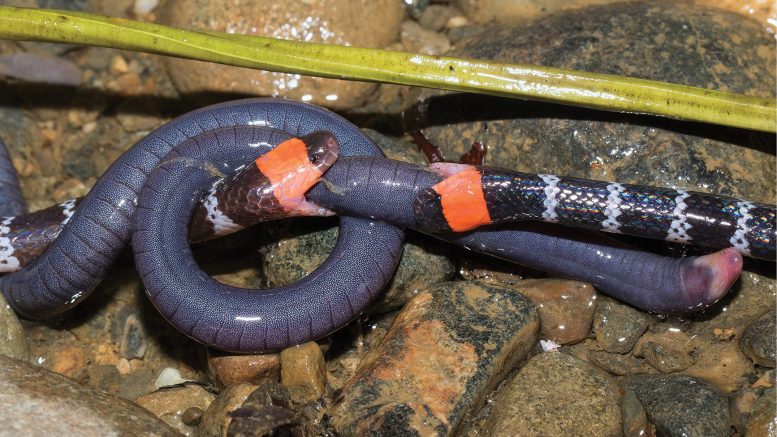
Two red-tailed coral snakes were seen engaging in a battle over a caecilian, marking the first recorded instance of kleptoparasitism in the wild among the Elapidae family.
Kleptoparasitism, or food theft, is a well-documented behavior in many animal species but is seldom reported among snakes in natural habitats.
The observation, detailed in a recent study published in the open-access journal Herpetozoa by Henrik Bringsøe and Niels Poul Dreyer, showcases the two Micrurus mipartitus snakes engaging in a tug-of-war over the limbless amphibian.
Two coral snakes competing over amphibian prey. Credit: Henrik Bringsøe and Niels Poul Dreyer
Elapid snakes are venomous and among the deadliest serpents in the world. There are more than 400 species comprising a very diverse group of snakes such as mambas, cobras, kraits, taipans, tiger snakes, death adders, sea snakes, and coral snakes.
The battle occurred in the dense rainforests of Valle del Cauca, western Colombia. Surprisingly, in the tussle, one snake also bit the body of the other. However, the researchers suggest this was likely accidental.
After 17 minutes of observation, the losing coral snake released its bite-hold on the caecilian. The winner then moved away from the losing snake which did not follow.
Credit: Henrik Bringsøe and Niels Poul Dreyer
The study suggests that while such behaviors may be more common in captivity due to controlled environments, their occurrence in nature has been largely underreported, likely due to the elusive nature of these reptiles and the challenges of observing them in their natural habitats.
“Snakes in captivity do that often when only one prey is offered in a terrarium with two or more snakes. But it is rather surprising that it has not been observed more frequently in the wild,” says lead author Henrik Bringsøe.
This case sheds light on the coral snake’s interactions with prey species. Caecilians, such as the one in this study, have shown remarkable adaptations such as toxin resistance and increased mucus production.
Reference: “Kleptoparasitism in Micrurus mipartitus (Squamata, Elapidae) competing for the same Caecilia sp. (Gymnophiona, Caeciliidae) in western Colombia” by Henrik Bringsøe and Niels Poul Dreyer, 22 March 2024, Herpetozoa.
DOI: 10.3897/herpetozoa.37.e112716